NISSAN NAVARA 2005 Repair Workshop Manual
Manufacturer: NISSAN, Model Year: 2005, Model line: NAVARA, Model: NISSAN NAVARA 2005Pages: 3171, PDF Size: 49.59 MB
Page 1131 of 3171
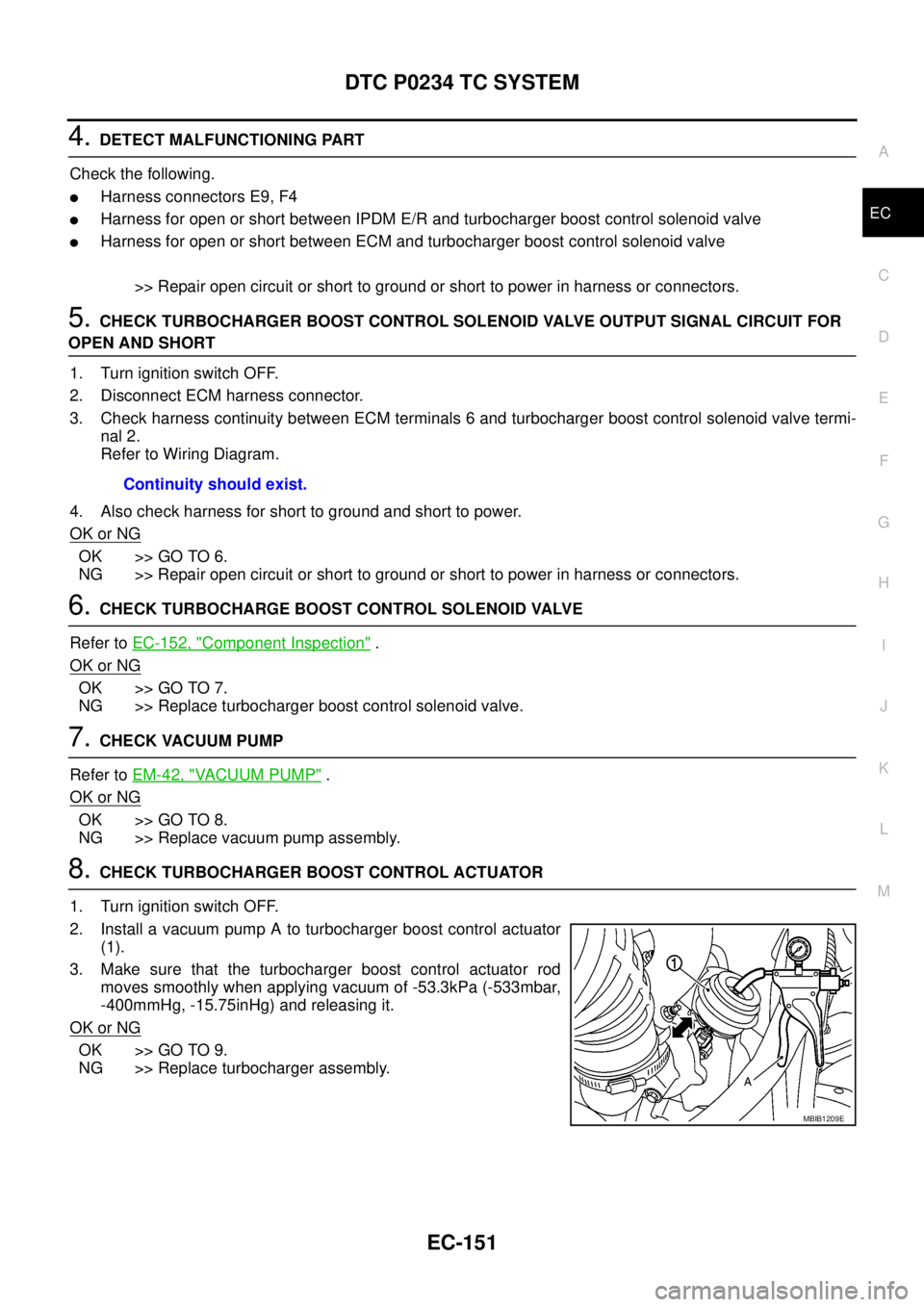
DTC P0234 TC SYSTEM
EC-151
C
D
E
F
G
H
I
J
K
L
MA
EC
4.DETECT MALFUNCTIONING PART
Check the following.
lHarness connectors E9, F4
lHarness for open or short between IPDM E/R and turbocharger boost control solenoid valve
lHarness for open or short between ECM and turbocharger boost control solenoid valve
>> Repair open circuit or short to ground or short to power in harness or connectors.
5.CHECK TURBOCHARGER BOOST CONTROL SOLENOID VALVE OUTPUT SIGNAL CIRCUIT FOR
OPEN AND SHORT
1. Turn ignition switch OFF.
2. Disconnect ECM harness connector.
3. Check harness continuity between ECM terminals 6 and turbocharger boost control solenoid valve termi-
nal 2.
Refer to Wiring Diagram.
4. Also check harness for short to ground and short to power.
OK or NG
OK >> GO TO 6.
NG >> Repair open circuit or short to ground or short to power in harness or connectors.
6.CHECK TURBOCHARGE BOOST CONTROL SOLENOID VALVE
Refer toEC-152, "
Component Inspection".
OK or NG
OK >> GO TO 7.
NG >> Replace turbocharger boost control solenoid valve.
7.CHECK VACUUM PUMP
Refer toEM-42, "
VACUUM PUMP".
OK or NG
OK >> GO TO 8.
NG >> Replace vacuum pump assembly.
8.CHECK TURBOCHARGER BOOST CONTROL ACTUATOR
1. Turn ignition switch OFF.
2. Install a vacuum pump A to turbocharger boost control actuator
(1).
3. Make sure that the turbocharger boost control actuator rod
moves smoothly when applying vacuum of -53.3kPa (-533mbar,
-400mmHg, -15.75inHg) and releasing it.
OK or NG
OK >> GO TO 9.
NG >> Replace turbocharger assembly.Continuity should exist.
MBIB1209E
Page 1132 of 3171
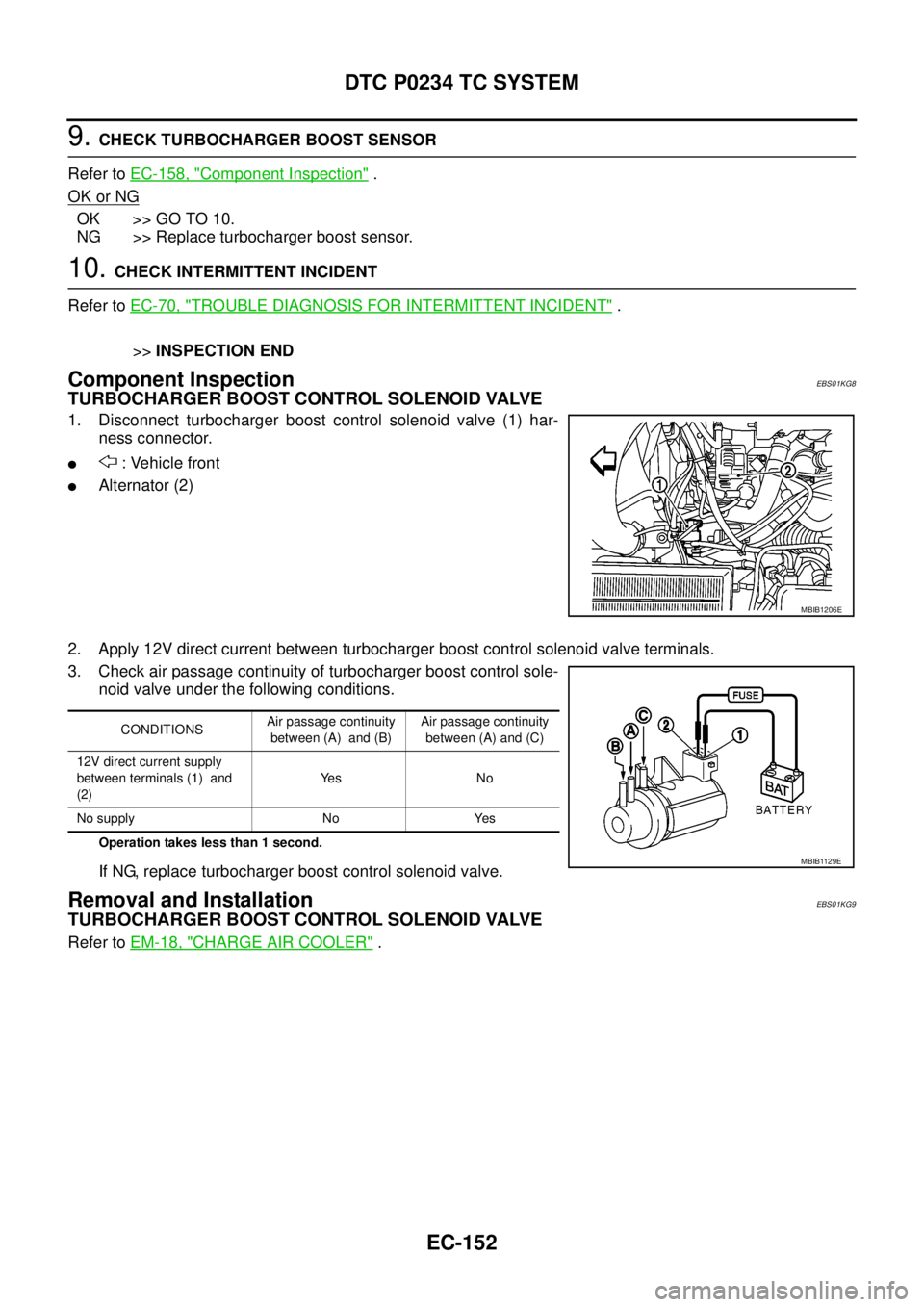
EC-152
DTC P0234 TC SYSTEM
9.CHECK TURBOCHARGER BOOST SENSOR
Refer toEC-158, "
Component Inspection".
OK or NG
OK >> GO TO 10.
NG >> Replace turbocharger boost sensor.
10.CHECK INTERMITTENT INCIDENT
Refer toEC-70, "
TROUBLE DIAGNOSIS FOR INTERMITTENT INCIDENT".
>>INSPECTION END
Component InspectionEBS01KG8
TURBOCHARGER BOOST CONTROL SOLENOID VALVE
1. Disconnect turbocharger boost control solenoid valve (1) har-
ness connector.
l: Vehicle front
lAlternator (2)
2. Apply 12V direct current between turbocharger boost control solenoid valve terminals.
3. Check air passage continuity of turbocharger boost control sole-
noid valve under the following conditions.
Operation takes less than 1 second.
If NG, replace turbocharger boost control solenoid valve.
Removal and InstallationEBS01KG9
TURBOCHARGER BOOST CONTROL SOLENOID VALVE
Refer toEM-18, "CHARGE AIR COOLER".
MBIB1206E
CONDITIONSAir passage continuity
between (A) and (B)Air passage continuity
between (A) and (C)
12V direct current supply
between terminals (1) and
(2)Ye s N o
No supply No Yes
MBIB1129E
Page 1133 of 3171
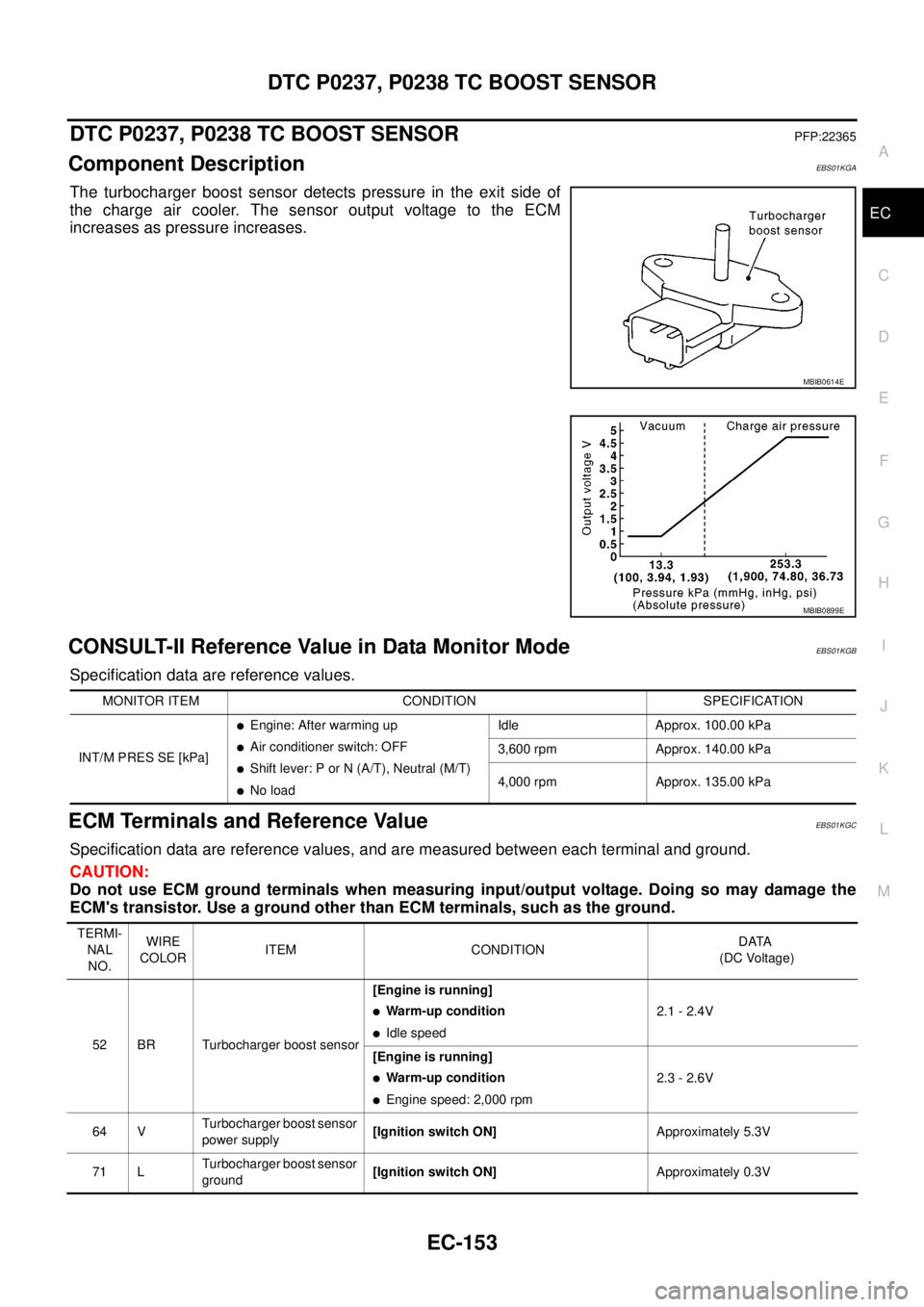
DTC P0237, P0238 TC BOOST SENSOR
EC-153
C
D
E
F
G
H
I
J
K
L
MA
EC
DTC P0237, P0238 TC BOOST SENSORPFP:22365
Component DescriptionEBS01KGA
The turbocharger boost sensor detects pressure in the exit side of
the charge air cooler. The sensor output voltage to the ECM
increases as pressure increases.
CONSULT-II Reference Value in Data Monitor ModeEBS01KGB
Specification data are reference values.
ECM Terminals and Reference ValueEBS01KGC
Specification data are reference values, and are measured between each terminal and ground.
CAUTION:
Do not use ECM ground terminals when measuring input/output voltage. Doing so may damage the
ECM's transistor. Use a ground other than ECM terminals, such as the ground.
MBIB0614E
MBIB0899E
MONITOR ITEM CONDITION SPECIFICATION
INT/M PRES SE [kPa]
lEngine: After warming up
lAir conditioner switch: OFF
lShift lever: P or N (A/T), Neutral (M/T)
lNo loadIdle Approx. 100.00 kPa
3,600 rpm Approx. 140.00 kPa
4,000 rpm Approx. 135.00 kPa
TERMI-
NAL
NO.WIRE
COLORITEM CONDITIONDATA
(DC Voltage)
52 BR Turbocharger boost sensor[Engine is running]
lWarm-up condition
lIdle speed2.1 - 2.4V
[Engine is running]
lWarm-up condition
lEngine speed: 2,000 rpm2.3 - 2.6V
64 VTurbocharger boost sensor
power supply[Ignition switch ON]Approximately 5.3V
71 LTurbocharger boost sensor
ground[Ignition switch ON]Approximately 0.3V
Page 1134 of 3171
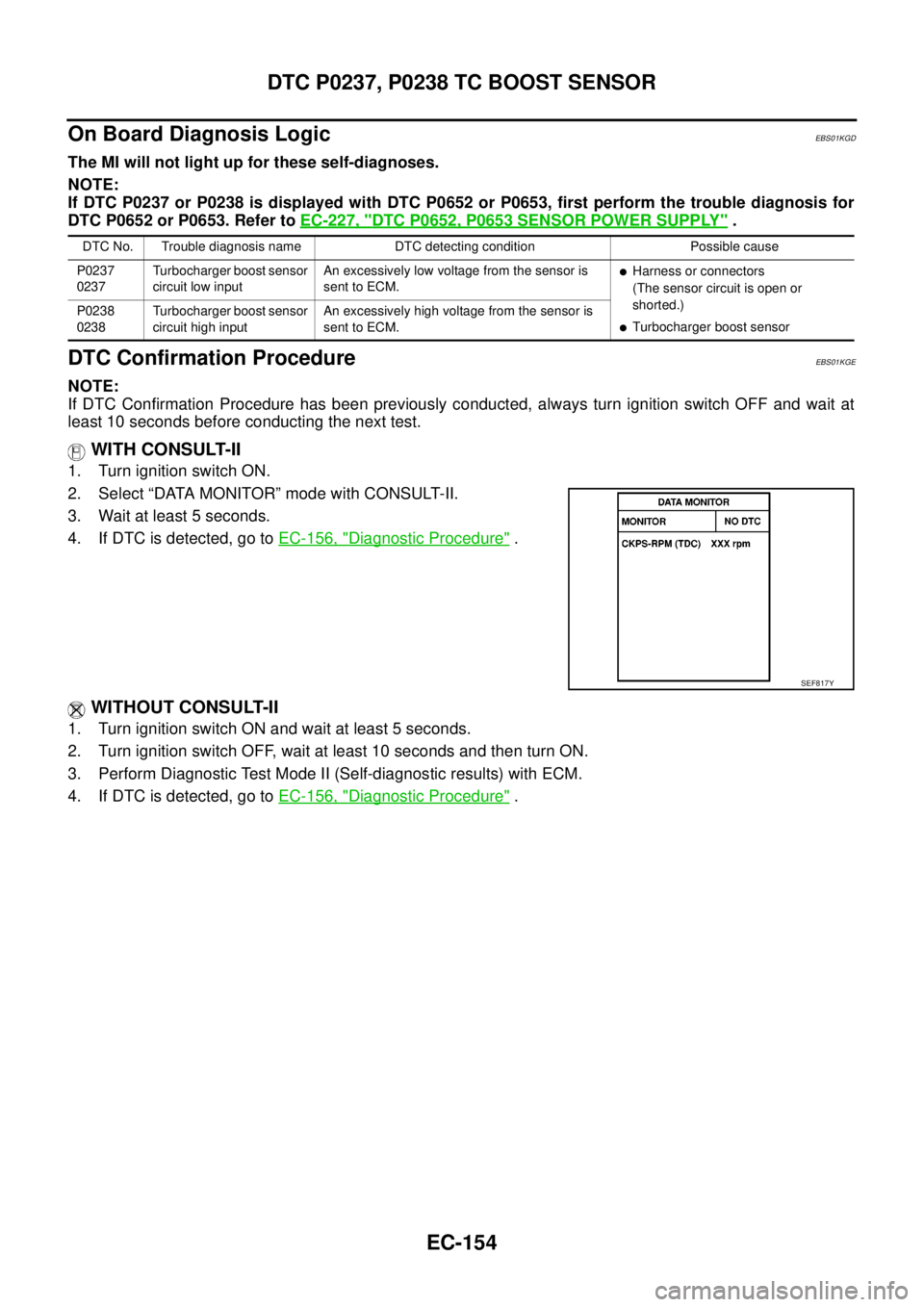
EC-154
DTC P0237, P0238 TC BOOST SENSOR
On Board Diagnosis Logic
EBS01KGD
The MI will not light up for these self-diagnoses.
NOTE:
If DTC P0237 or P0238 is displayed with DTC P0652 or P0653, first perform the trouble diagnosis for
DTC P0652 or P0653. Refer toEC-227, "
DTC P0652, P0653 SENSOR POWER SUPPLY".
DTC Confirmation ProcedureEBS01KGE
NOTE:
If DTC Confirmation Procedure has been previously conducted, always turn ignition switch OFF and wait at
least 10 seconds before conducting the next test.
WITH CONSULT-II
1. Turn ignition switch ON.
2. Select “DATA MONITOR” mode with CONSULT-II.
3. Wait at least 5 seconds.
4. If DTC is detected, go toEC-156, "
Diagnostic Procedure".
WITHOUT CONSULT-II
1. Turn ignition switch ON and wait at least 5 seconds.
2. Turn ignition switch OFF, wait at least 10 seconds and then turn ON.
3. Perform Diagnostic Test Mode II (Self-diagnostic results) with ECM.
4. If DTC is detected, go toEC-156, "
Diagnostic Procedure".
DTC No. Trouble diagnosis name DTC detecting condition Possible cause
P0237
0237Turbocharger boost sensor
circuit low inputAn excessively low voltage from the sensor is
sent to ECM.
lHarness or connectors
(The sensor circuit is open or
shorted.)
lTurbocharger boost sensor P0238
0238Turbocharger boost sensor
circuit high inputAn excessively high voltage from the sensor is
sent to ECM.
SEF817Y
Page 1135 of 3171
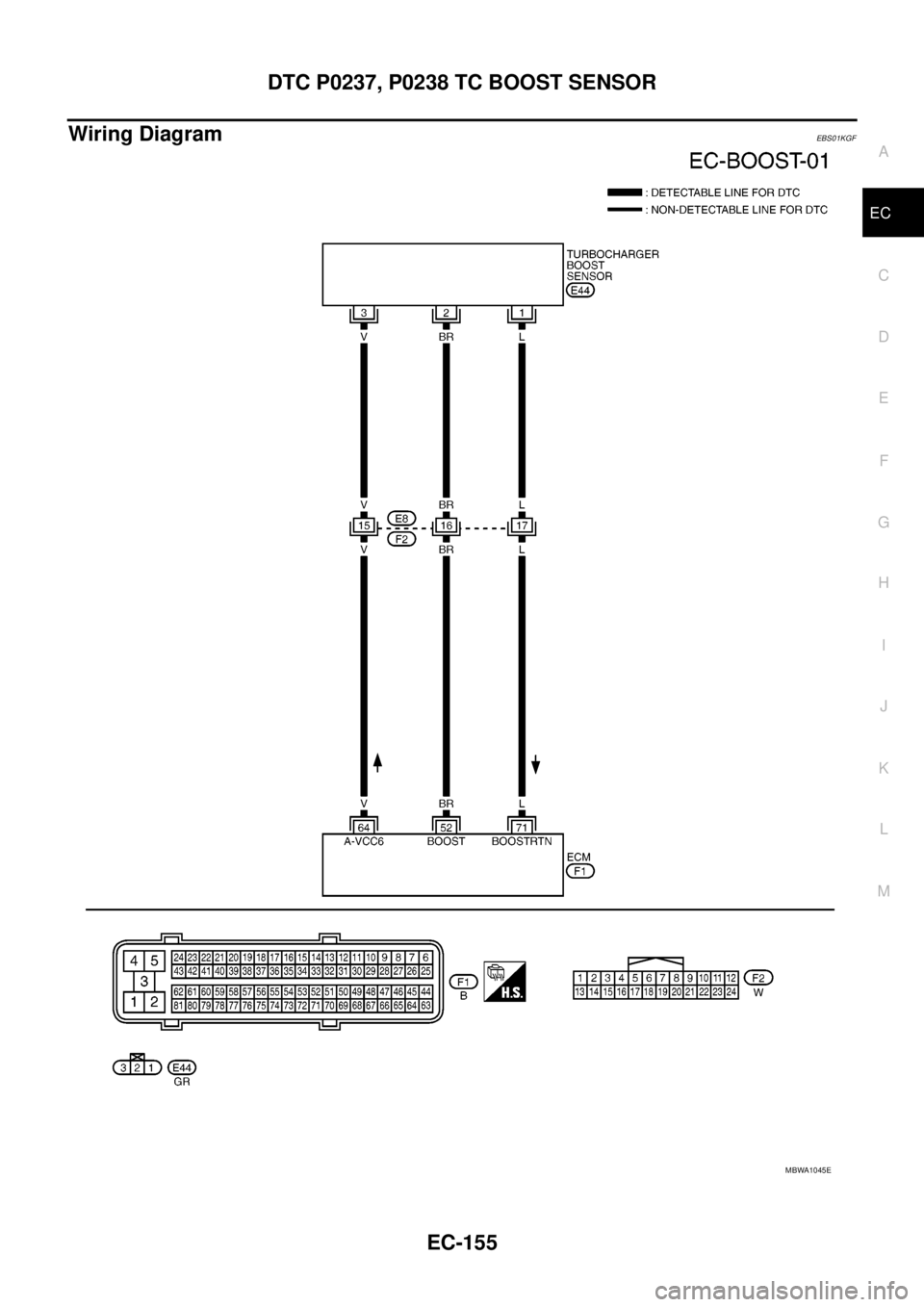
DTC P0237, P0238 TC BOOST SENSOR
EC-155
C
D
E
F
G
H
I
J
K
L
MA
EC
Wiring DiagramEBS01KGF
MBWA1045E
Page 1136 of 3171

EC-156
DTC P0237, P0238 TC BOOST SENSOR
Diagnostic Procedure
EBS01KGG
1.CHECK GROUND CONNECTIONS
1. Turn ignition switch OFF.
2. Loosen and retighten three ground screws on the body.
Refer toEC-78, "
Ground Inspection".
OK or NG
OK >> GO TO 2.
NG >> Repair or replace ground connections.
2.CHECK TURBOCHARGER BOOST SENSOR POWER SUPPLY CIRCUIT
1. Disconnect turbocharge boost sensor (1) harness connector.
2. Turn ignition switch ON.
3. Check voltage between turbocharge boost sensor terminal 3
and ground with CONSULT-II or tester.
OK or NG
OK >> GO TO 3.
NG >> Repair open circuit or short to ground or short to power
in harness or connectors.
: Vehicle front
1. Body ground E21 2. ECM 3. Body ground E41
4. A/C high-pressure service valve 5. ABS actuator and electric unit
(control unit)6. Body ground E61
MBIB1218E
MBIB1210E
Voltage: Approximately 5.3V
PBIB0138E
Page 1137 of 3171

DTC P0237, P0238 TC BOOST SENSOR
EC-157
C
D
E
F
G
H
I
J
K
L
MA
EC
3.CHECK TURBOCHAGER BOOST SENSOR GROUND CIRCUIT FOR OPEN AND SHORT
1. Turn ignition switch OFF.
2. Disconnect ECM harness connector.
3. Check harness continuity between turbocharger boost sensor terminal 1 and ECM terminal 71.
Refer to Wiring Diagram.
4. Also check harness for short to ground and short to power.
OK or NG
OK >> GO TO 4.
NG >> Repair open circuit or short to ground or short to power in harness or connectors.
4.CHECK TURBOCHAGER BOOST SENSOR INPUT SIGNAL CIRCUIT FOR OPEN AND SHORT
1. Check harness continuity between ECM terminal 52 and turbocharger boost sensor terminal 2. Refer to
Wiring Diagram.
2. Also check harness for short to ground and short to power.
OK or NG
OK >> GO TO 5.
NG >> Repair open circuit or short to ground or short to power in harness connectors.
5.CHECK TURBOCHARGER BOOST SENSOR
Refer toEC-158, "
Component Inspection".
OK or NG
OK >> GO TO 6.
NG >> Replace turbocharger boost sensor.
6.CHECK INTERMITTENT INCIDENT
Refer toEC-70, "
TROUBLE DIAGNOSIS FOR INTERMITTENT INCIDENT".
>>INSPECTION END Continuity should exist.
Continuity should exist.
Page 1138 of 3171
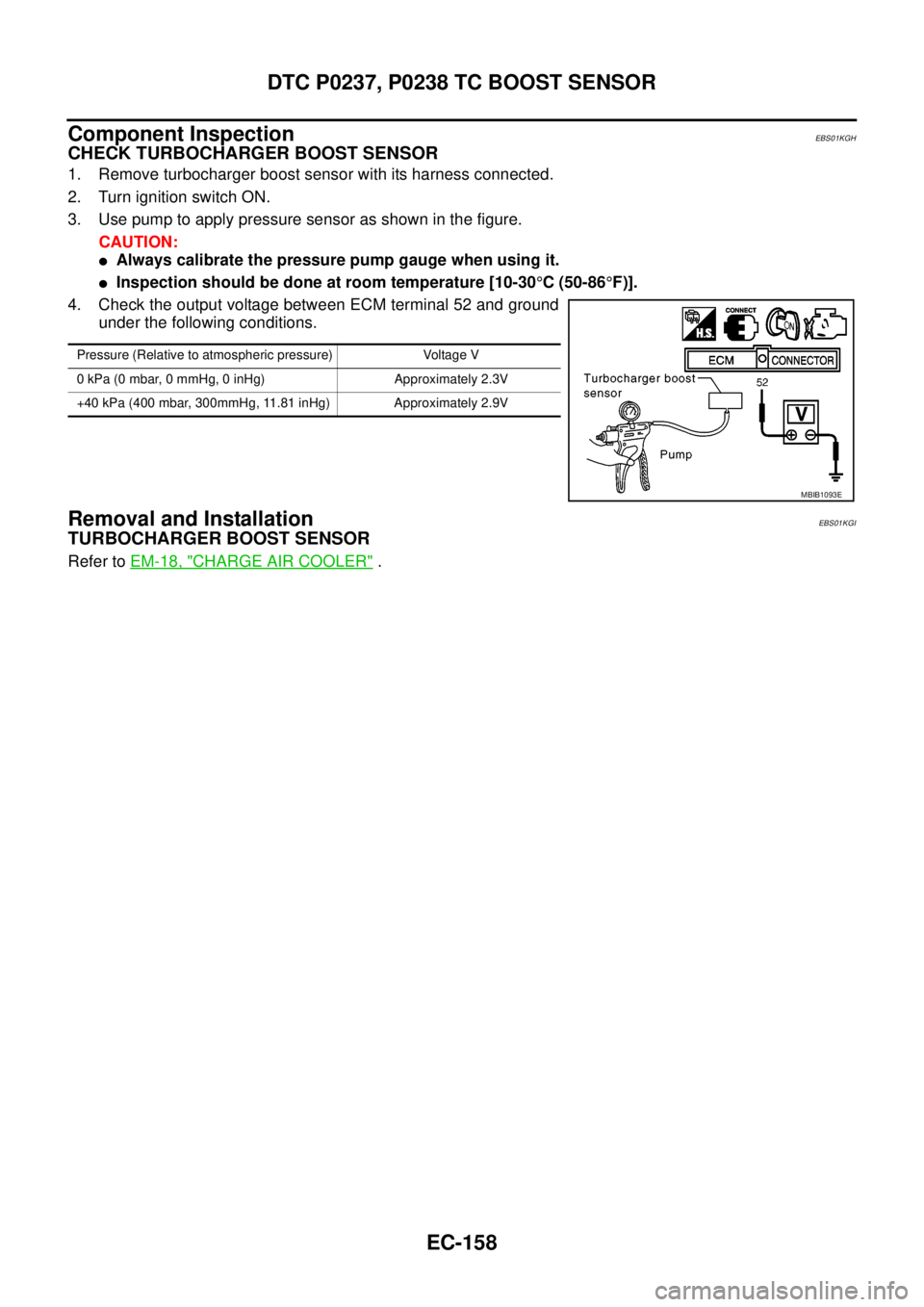
EC-158
DTC P0237, P0238 TC BOOST SENSOR
Component Inspection
EBS01KGH
CHECK TURBOCHARGER BOOST SENSOR
1. Remove turbocharger boost sensor with its harness connected.
2. Turn ignition switch ON.
3. Use pump to apply pressure sensor as shown in the figure.
CAUTION:
lAlways calibrate the pressure pump gauge when using it.
lInspection should be done at room temperature [10-30°C(50-86°F)].
4. Check the output voltage between ECM terminal 52 and ground
under the following conditions.
Removal and InstallationEBS01KGI
TURBOCHARGER BOOST SENSOR
Refer toEM-18, "CHARGE AIR COOLER".
Pressure (Relative to atmospheric pressure) Voltage V
0 kPa (0 mbar, 0 mmHg, 0 inHg) Approximately 2.3V
+40 kPa (400 mbar, 300mmHg, 11.81 inHg) Approximately 2.9V
MBIB1093E
Page 1139 of 3171
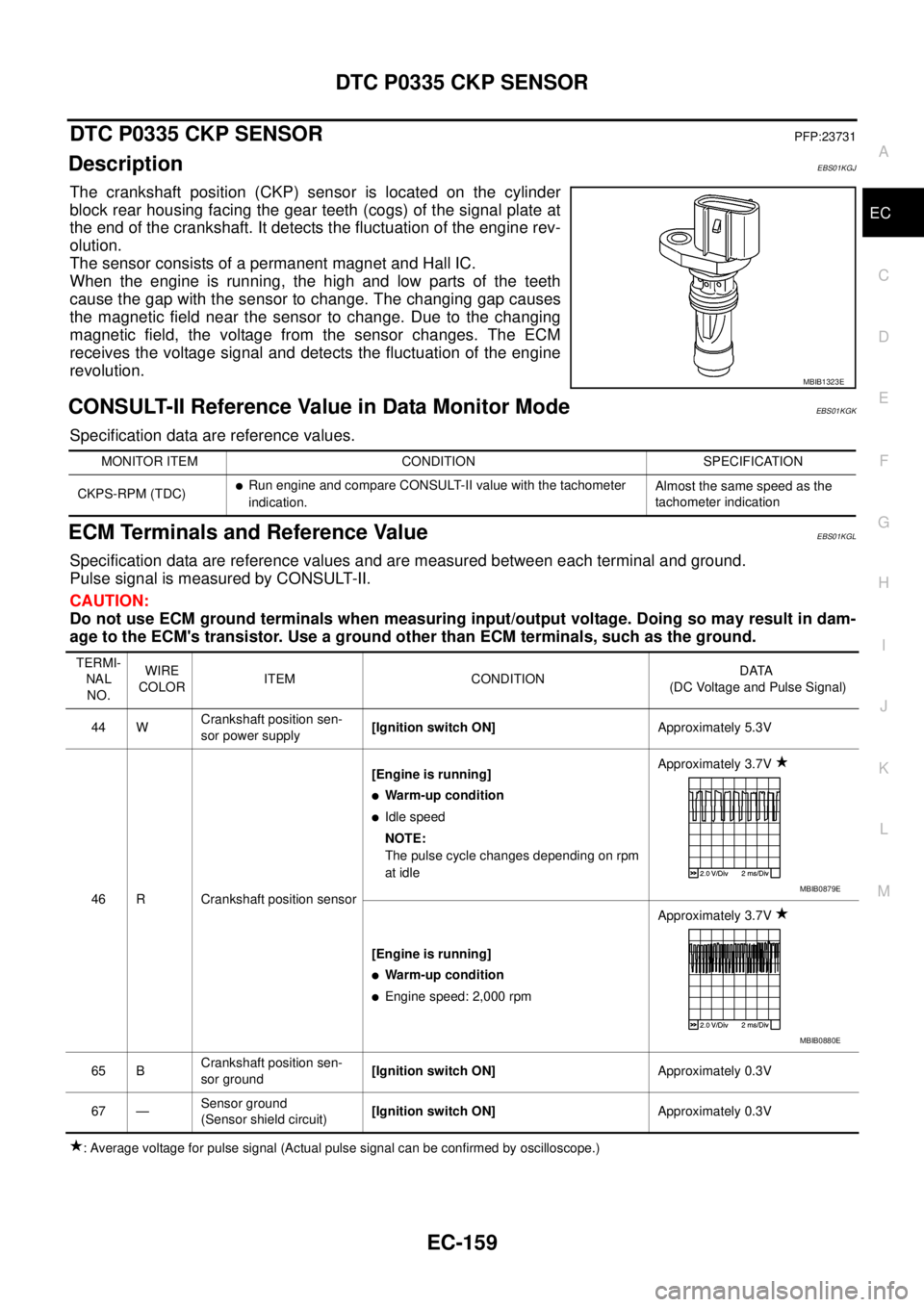
DTC P0335 CKP SENSOR
EC-159
C
D
E
F
G
H
I
J
K
L
MA
EC
DTC P0335 CKP SENSORPFP:23731
DescriptionEBS01KGJ
The crankshaft position (CKP) sensor is located on the cylinder
block rear housing facing the gear teeth (cogs) of the signal plate at
the end of the crankshaft. It detects the fluctuation of the engine rev-
olution.
The sensor consists of a permanent magnet and Hall IC.
When the engine is running, the high and low parts of the teeth
cause the gap with the sensor to change. The changing gap causes
the magnetic field near the sensor to change. Due to the changing
magnetic field, the voltage from the sensor changes. The ECM
receives the voltage signal and detects the fluctuation of the engine
revolution.
CONSULT-II Reference Value in Data Monitor ModeEBS01KGK
Specification data are reference values.
ECM Terminals and Reference ValueEBS01KGL
Specification data are reference values and are measured between each terminal and ground.
Pulse signal is measured by CONSULT-II.
CAUTION:
Do not use ECM ground terminals when measuring input/output voltage. Doing so may result in dam-
age to the ECM's transistor. Use a ground other than ECM terminals, such as the ground.
: Average voltage for pulse signal (Actual pulse signal can be confirmed by oscilloscope.)
MBIB1323E
MONITOR ITEM CONDITION SPECIFICATION
CKPS-RPM (TDC)
lRun engine and compare CONSULT-II value with the tachometer
indication.Almost the same speed as the
tachometer indication
TERMI-
NAL
NO.WIRE
COLORITEM CONDITIONDATA
(DC Voltage and Pulse Signal)
44 WCrankshaft position sen-
sor power supply[Ignition switch ON]Approximately 5.3V
46 R Crankshaft position sensor[Engine is running]
lWarm-up condition
lIdle speed
NOTE:
The pulse cycle changes depending on rpm
at idleApproximately 3.7V
[Engine is running]
lWarm-up condition
lEngine speed: 2,000 rpmApproximately 3.7V
65 BCrankshaft position sen-
sor ground[Ignition switch ON]Approximately 0.3V
67 —Sensor ground
(Sensor shield circuit)[Ignition switch ON]Approximately 0.3V
MBIB0879E
MBIB0880E
Page 1140 of 3171

EC-160
DTC P0335 CKP SENSOR
On Board Diagnosis Logic
EBS01KGM
NOTE:
If DTC P0335 is displayed with DTC P0652 or P0653, first perform the trouble diagnosis for DTC P0652
or P0653. Refer toEC-227, "
DTC P0652, P0653 SENSOR POWER SUPPLY".
DTC Confirmation ProcedureEBS01KGN
NOTE:
If DTC Confirmation Procedure has been previously conducted, always turn ignition switch OFF and wait at
least 10 seconds before conducting the next test.
WITH CONSULT-II
1. Turn ignition switch ON.
2. Select “DATA MONITOR” mode with CONSULT-II.
3. Start engine and let it idle for at least 5 seconds.
If engine can not start, keep ignition switch at START position for
5 seconds.
4. If DTC is detected, go toEC-162, "
Diagnostic Procedure".
WITHOUT CONSULT-II
1. Start engine and let it idle for at least 5 seconds.
If engine can not start, keep ignition switch at START position for 5 seconds.
2. Turn ignition switch OFF, wait at least 10 seconds and then turn ON.
3. Perform Diagnostic Test Mode II (Self-diagnostic results) with ECM.
4. If DTC is detected, go toEC-162, "
Diagnostic Procedure".
DTC No. Trouble diagnosis name DTC detecting condition Possible cause
P0335
0335Crankshaft position sen-
sor circuitCrankshaft position sensor signal is not detect
by the ECM when engine is running.
lHarness or connectors
(The sensor circuit is open or
shorted.)
lCrankshaft position sensor
SEF817Y